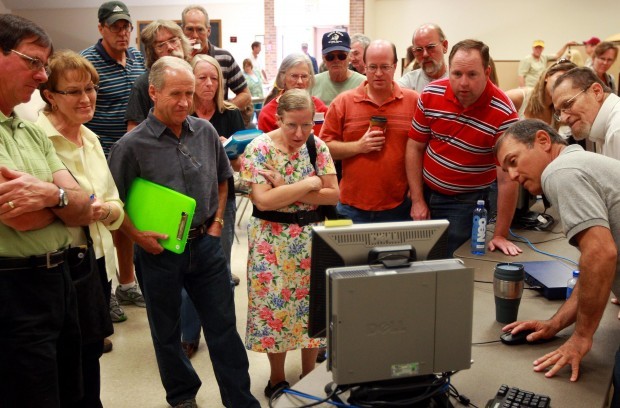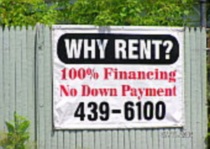StarTribune Wyoming’s News Source
August 24, 2012
Natrona County tax sale disperses liens on nearly 700 properties
Hopeful investors watch a computer screen at the start of the Natrona County tax sale Thursday.
Each delinquent property was awarded to a randomly-selected buyer, who then had the opportunity to purchase the associated lien from the county treasurer’s office in exchange for taxes owed. Property owners have up to four years to pay their back taxes, after which the new lienholder has the right to foreclose on the property.
Registration lasted nearly two hours for a sale that took all of 12 minutes
The process
“We assign [each investor] a number, and put all their numbers into a random number generator,” Natrona County Treasurer Tom Doyle said.
The computer generates a list of investor identification numbers that are matched to properties listed in public advertisements. The investor then had the opportunity to purchase the associated lien from the county treasurer’s office in exchange for taxes owed.
Liens on 691 Natrona County properties were up for sale this year. Most properties [415] were simply vacant lots, according to Doyle, although he estimated about 30 percent [207]were Natrona County homes and 10 percent [69] were commercial properties.
If a person is 18 or older, [has] a Social Security number, $40 registration fee, and the capital to front the amount owed by the delinquent was all that was needed to join
Thursday’s ranks of investors.
“I started out small and just kept saving the money I got back,” Dalton said. “It’s worked very well.” Dalton recruited 34 “agents” to buy tax liens for him at Thursday’s sale, a practice regularly used by big tax-sale buyers…“I get representatives to go to the other counties,” Dalton said…He estimated the going rate for an agent for a day’s work at a tax sale was between $25 and $75.
Four years from now
Doyle estimated about 3 to 4 percent of Thursday’s tax sales will go to tax deed…“You never want to do anything like that,” [foreclose] Jones said. “But you’ve [tax delinquents] got to be responsible for your actions.”
See the full article: The Natrona County tax sale
********************
Coach Mitch’s REFLECTIONS™
This article and tax sale is a great example of that old axiom “Everyone’s got two things, an opinion and a rear end.”
I don’t invest in tax liens. I don’t necessarily think tax liens are a bad investment; how could they be, Dalton (above) has done very well with them.
However, there is a little understood financial axiom that I state as, “Your opportunity cost is your biggest loss.” We don’t know how much we have lost by choosing to buy a tax lien and choosing to NOT buy the property.
Opportunity has a Cost
Definition: when a particular opportunity is chosen over other opportunities, the loss of potential gain from the other alternatives is the Opportunity Cost.
15% vs. 200%
When I tell people that, “I don’t even look at a property unless I think I can make a 200% profit.” the reaction typically is – silence. People don’t know how to respond to a seemingly outlandish claim like making 200% profit.
Risk vs. Reward
We all hear the same nostrums: “High risk, high reward.” “It takes money to make money.”
I was part of the security industry, carrying various licenses and attempting to sell people on the ideas that I was trained in, though indoctrinated would be a better word.
I was told that the most important idea within the investing world was the retention of principle. I was taught that, no matter what, an investor’s principle was not to be lost. The investor will not be happy with low returns, but you will no longer have a hard won client if you lose their principle.
People are conditioned to only expect low returns and safety is the paramount concept. You can win any argument by saying that the investment is risky. But, sadly the supposed big returns are relegated to investments like oil wells, when in reality, the insiders make the big money.
I let my security licenses lapse because I came to understand that in order to create good profits on a regular basis for my clients, I would have to regularly disseminate insider information and it would only be a matter of time until I would end up in jail.
Not losing principle has some merit
Back in the mid 1970’s I did a good deal of gorilla investing, that is, I invested options and I was in the market in the morning and sold out at the end of the day. In and out. In and out.
I was doing very well – until I lost everything in one trade, in five minutes. That is the stock market; rich one day, poor the next. I didn’t know that it is purposefully set up that way.
Control
I have told the story of how I lost everything in a previous blog, but the moral of the story is that through my stock debacle, I came to understand that the most important investing principle is: have control. Mine is a typical American story of picking yourself up by the boots. I went from losing all to understanding how to make more, consistently and safely.
With stocks you have no control; you don’t even have meaningful input. When it comes to control, your few shares of stock are about as effective as finding an ocean in the desert. Management does what it wishes and you are along for the ride, with no say in the matter.
Without control, you might as well be betting on the weather – you are at the mercy of the G-d’s.
REI
Only real estate investing provides the control needed to make good investment decisions. You are in charge of everything, and based on good research, you can remove virtually all risk.
You decide when to invest, pick the geographic area, the type of real estate, the location, the specific property, the investing formula, how much to offer, how or if to improve the property, who to consider for tenants and the specific conditions under which you will rent, when to raise rents, when to evict, who should cut the grass, shovel the snow, repair a roof, etc.
Very nearly the only risk is the unforeseen action of a government official like a building inspector. All else can be accounted for with good research. And, with good research, you can anticipate many market conditions,using Coach Mitch’s “famous $1 Option.”™ to take control of property in the path of progress.
EXAMPLE: You contact the Department of Transportation and via public records you find that a new exit ramp is going to be built, that the monies are in the budget and the anticipated start date. It hasn’t even been announced in the newspapers yet. Do I even have to say that you can option property around the proposed exit for $1. a parcel. If it works out, you make a killing. If it doesn’t, you lose a few dollars. Try to replicate that ROI with any other investment!
Nothing beats real estate for solid returns on investment, ROI, nothing.
Tax Delinquent Property
Investing in tax liens are a very good way to make a decent ROI, from 8% to 24%, with 15% being about the average. When comparing a tax lien investment to a CD or a stock or a bond, the tax lien will almost always come out ahead; a 15% tax lien wins every time against a 1% CD.
However
Tax deeds are really where the action is. When tax lien investors tell stories, the ‘big fish tail’ is always the story about how they bought a tax lien expecting a 15% ROI and they made a killing because they ended up getting the property free and clear of liens.
TLC investors think they are very smart, but
to my way of thinking, why wait for the 1 in 100 tax liens to default into a property? Why not go after the property right away?
Seeking the tax delinquent property prior to the tax auction is the essence of Coach Mitch’s “Ridiculously Simple System…”™ .
“It’s not a risk if you create the end result.” – Coach Mitch 2012
The issue is simple, find someone who is in financial trouble, who also has significant equity in their tax delinquent property and make a deal with them. That’s it.
The reality is that many will hold out for high prices, a situation I deal with via Coach Mitch’s “famous $1 Option.”™.
The reality is also that a small percentage will be so beat up, so desirous of moving on that you will be able to get the property for very little, 10% to 30% of the current fair market value, FMV.
The reality is also that a small percentage will simply give you the property for $50 to $500.
EXAMPLE
A new student and I studied his home county’s tax delinquent data base. There are a minimum of 3200 properties that are tax delinquent for at least three years. There are many more that are tax delinquent for two years and just one year. There are probably over 10000 properties in that one county that are at risk.
Thank goodness that most will be redeemed. If the owners of all these properties were to not pay the taxes, and have the property sold at auction, then there would be blood in the streets, and justifiably so.
The good part, in fact, the great part, is that this student has so many target rich opportunities.
As the article portrays, the student could invest in TLC’s, say $1000 at 15% each year, paying three or four years taxes, investing $4000 and making $600. OR
This student can do some research, pick his best leads, probably about 500, market to them, receiving mail returns from about 10 – 15% of prospects, and negotiate at his leisure – all PRIOR to the tax auction.
The Opportunity
Tax liens are a good investment. Tax deeds gotten prior to the tax deed auction are a great investment.
When a student does my course in a serious way, then within 90 days, the typical profit from a student’s first transaction is over $30000!
Which is better, $30000 in 90 days or $600 in four years? If you choose tax liens, you lose $29400. That’s your opportunity cost.
Coach Mitch’s “Ridiculously Simple System…”™ is available for a mere $297.
The Cost
Not doing something to move yourself forward.
G-d Bless US,








Leave a Reply